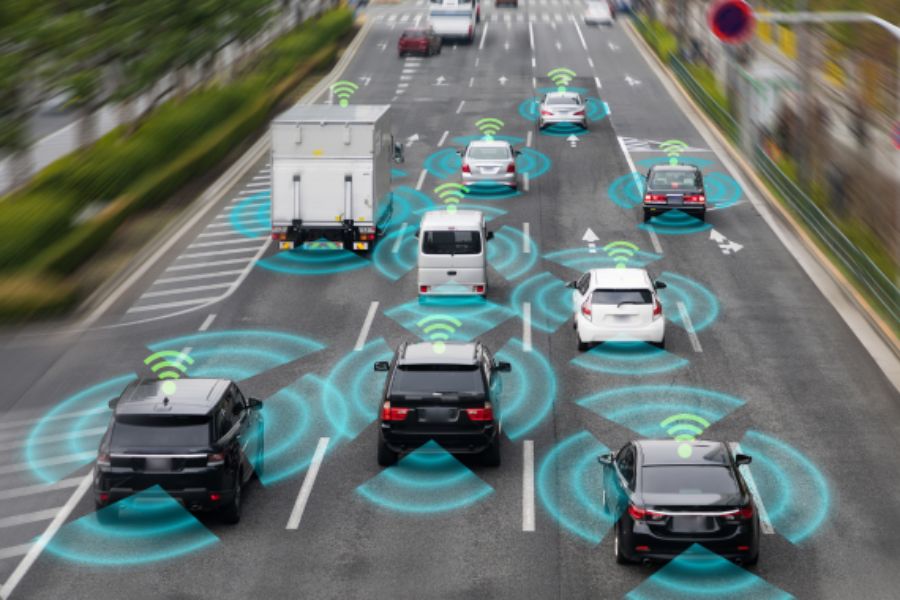Infrastructure is Key to Future Broadband Deployment

The importance of improving the country’s bandwidth bottleneck has become increasingly evident in recent years. To reach the desired – and necessary – state of broadband connectivity, local, state, and federal policy makers have turned to the transportation industry as a partner in achieving an infrastructure that can support long-term economic vitality.
Broadband, the ubiquitous technology that allows us to enjoy internet at home, that carries data to manage our transportation network, and that will eventually enable connected and automated vehicles (CAVs) to navigate roads, is not created magically. A wireless cell tower that gives your phone or modem a signal requires a connection to a broadband backbone. Without access to that broadband network, high-speed internet access is not possible, leaving many rural communities at a disadvantage. As data collection and transmission needs rapidly multiply, policy makers are taking action so as not to fall behind.
Interests Converge: Broadband Infrastructure for Deeper Community Connection
Even before a global pandemic closed businesses and schools and forced the world to rely on digital connectivity, there was a growing interest from public policy makers and governors to bring broadband access to more rural parts of the country. America is behind other parts of the world where fiber connectivity is already standard, and leaders recognize the importance of broadband in creating economic growth and supporting educational outcomes. To support broadband buildout and thus economic development, federal agencies like the USDA have made significant funds available to broadband operators, encouraging them to build where it would not otherwise be feasible without subsidies.
Meanwhile, as departments of transportation (DOTs) and other roadway operators grapple with how to fund desperately needed infrastructure repair, they too have recognized the need for far greater wireless service along interstates and highways. In 2017, nearly half of Florida lay in Hurricane Irma’s “cone of uncertainty,” forcing millions to evacuate northward. This was an awakening for the respective DOTs who realized their existing networks were not equipped to handle the increase in wireless connectivity demand that was sure to come. Additionally, most states do not have the operational capacities to accommodate increasing all-electronic tolling (AET) and ITS technologies. Some northern turnpike authorities that are modernizing their roadways have found that their antiquated microwave systems cannot even support current video feeds, let alone the future additional feeds necessary for AET.
While elected officials advocate for increased broadband to grow economies and breakdown the urban/rural divide, the transportation industry is also at a critical point in needing to expand our fiber optic network. Data needs increase by the second, and building broadband is integral to creating a safer, more efficient, and connected infrastructure.
Public-Private Partnership: A Solution for All
Historically, the private sector has relied on railroad right-of-way or private easements to build its long-haul broadband networks. But the process can be cumbersome and costly – having to negotiate with dozens of landowners for access. And, of course, private operators will only look to build where it will be profitable. Many state DOTs currently charge high access fees and have robust requirements to access their right-of-way, which make it far less attractive for private network developers. This arrangement has resulted in large capacity networks that run parallel or nearby interstate right-of-way, but not within the ROW where DOTs can easily access the fiber.
As interests align, a new model has emerged that creates advantages for all parties. With increased federal funding through the USDA, BUILD, and INFRA grants, DOTs are aiming to build or move existing broadband networks onto their right of way, where they’ll have access to meet the ever-growing future needs. Using a public-private partnership (P3) model, private operators can negotiate with a single entity, for instance a state DOT, rather than with dozens or even hundreds of property owners for land access. Additionally, operators are aided in expanding their network, receiving upfront capital cost contributions and more favorable conditions for access from the participating DOTs in exchange for long term revenue sharing. And, from a rural broadband perspective, these types of projects get the backbone of the network to places where it might not otherwise have been feasible. Rural communities that are currently 50 or 100 miles from the nearest fiber access, could be only a few miles away if there’s fiber running alongside the interstate.
Getting it Right
With bipartisan support, federal funding, and an ever-growing need, it’s clear that the buildout of broadband will continue to be a top priority, but early attempts at these types of projects have been ineffective. Public agencies and governments need an intermediary who understands the technology, the need, the commercialization considerations, and the construction of broadband infrastructure. An informed consultant can help identify and mitigate contract risks; can inform on proper construction oversight and techniques; and can advise on commercialization and long-term agreements.
RS&H has industry experts who will apply lessons learned to make your project a success. To learn more about our capabilities, reach out to Bryan Kendro.
Learn more about our construction management services for your next project.




